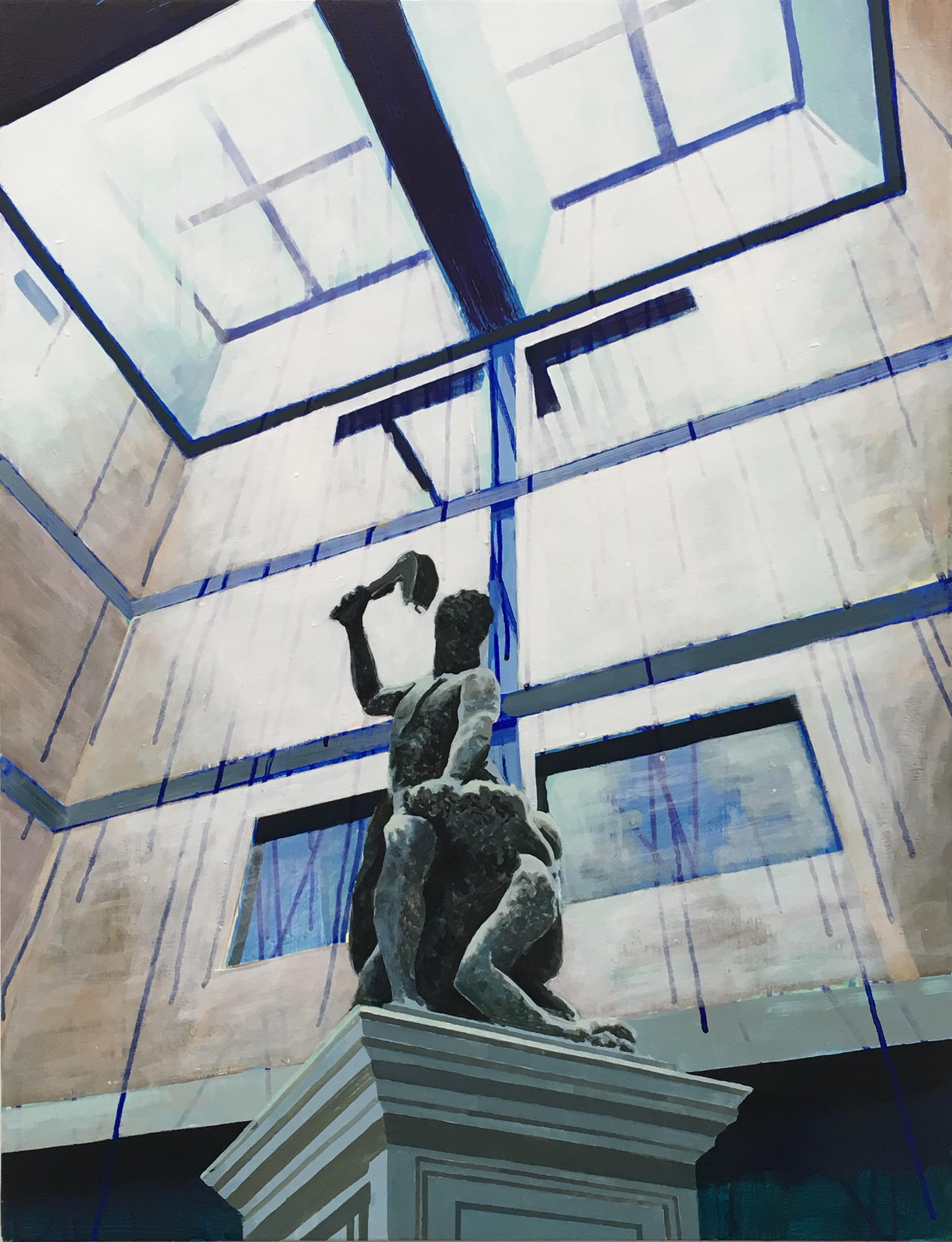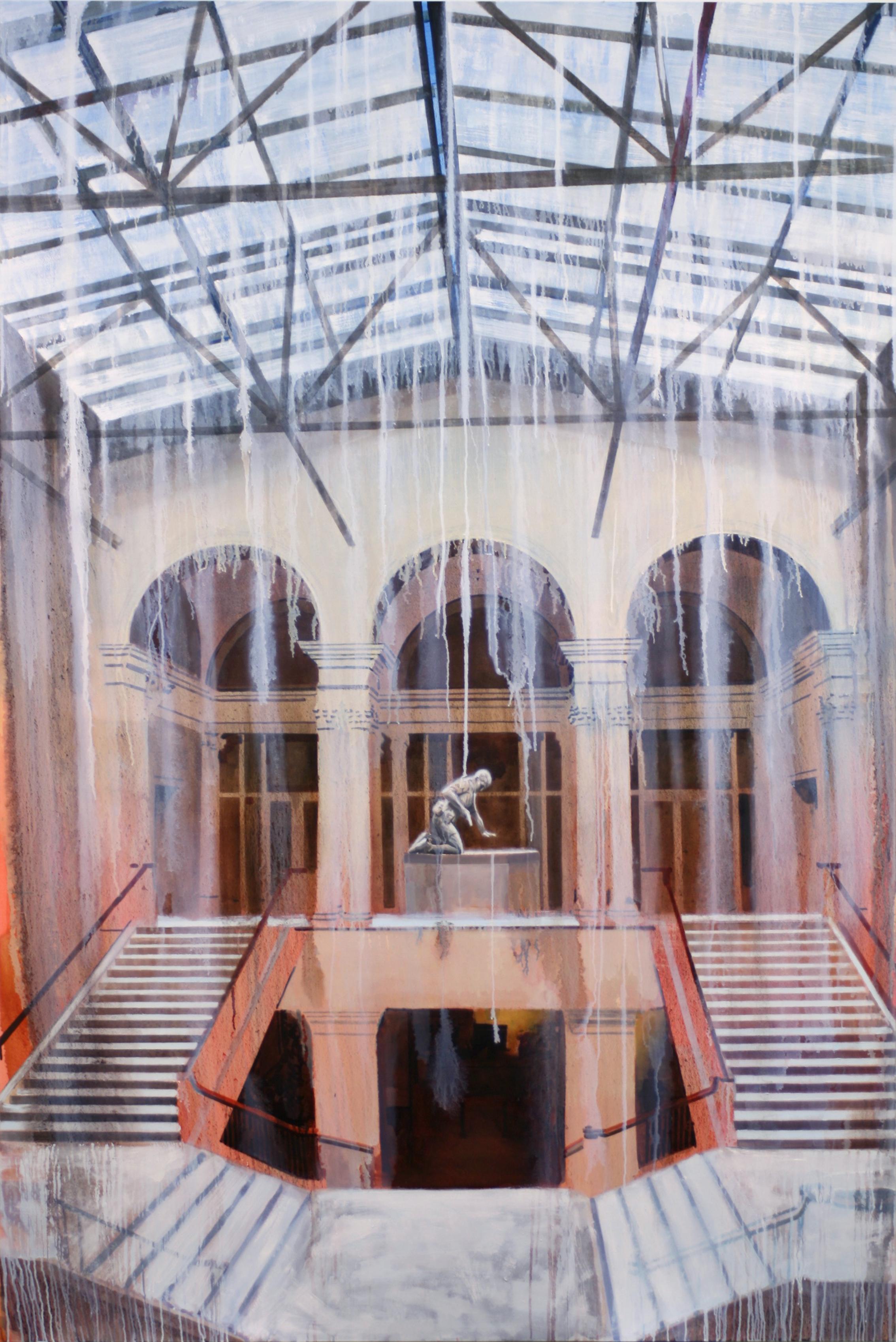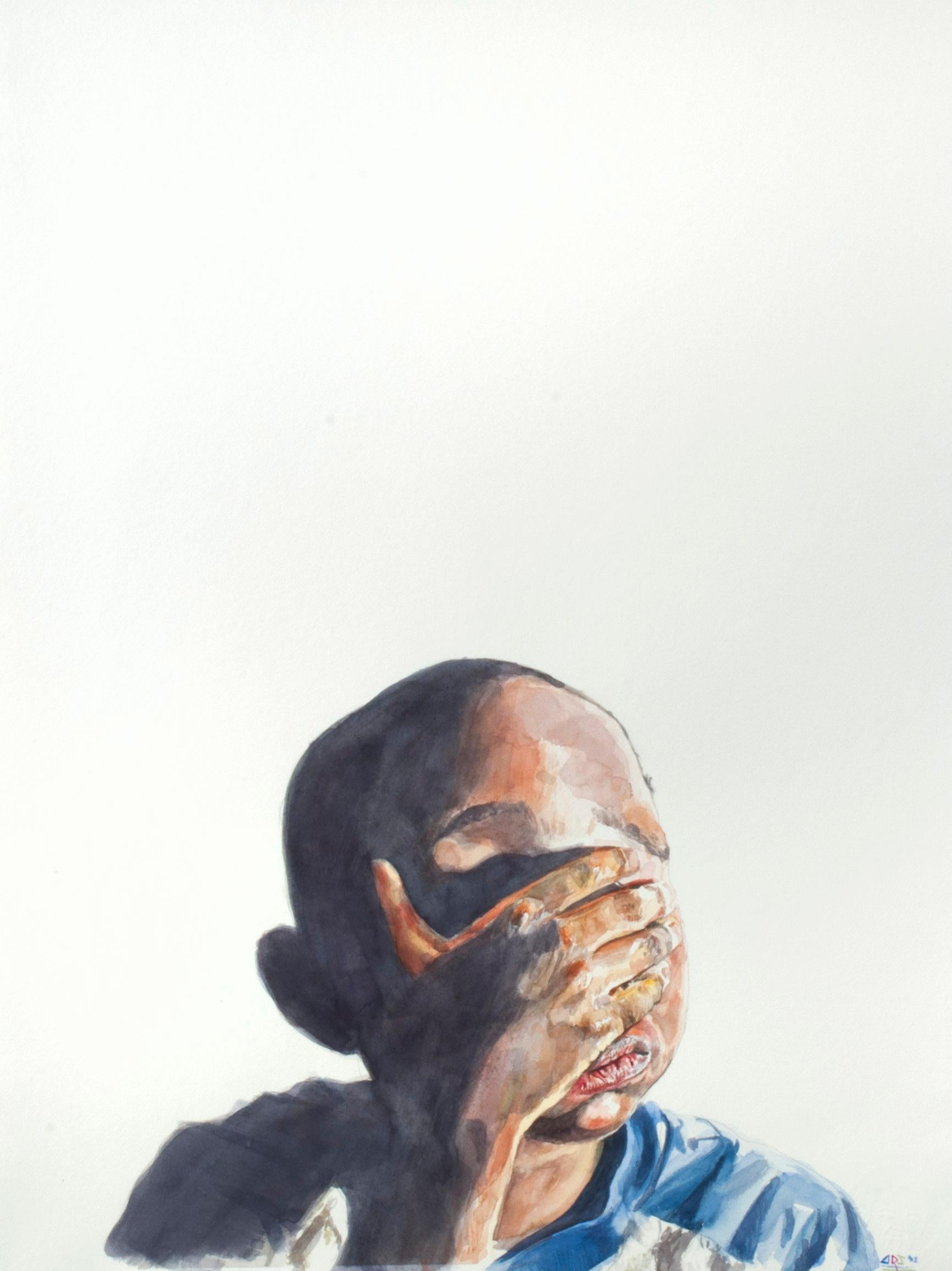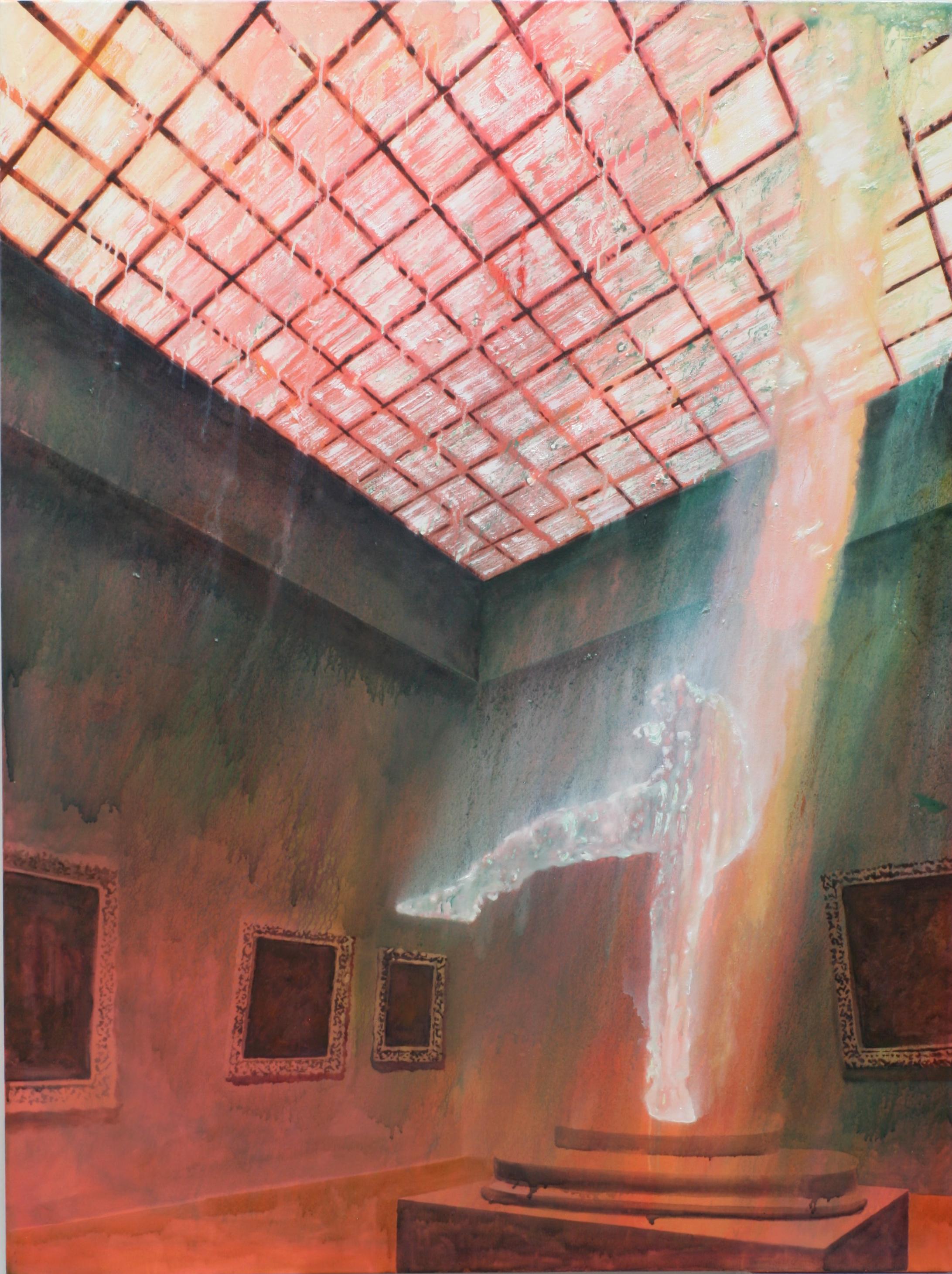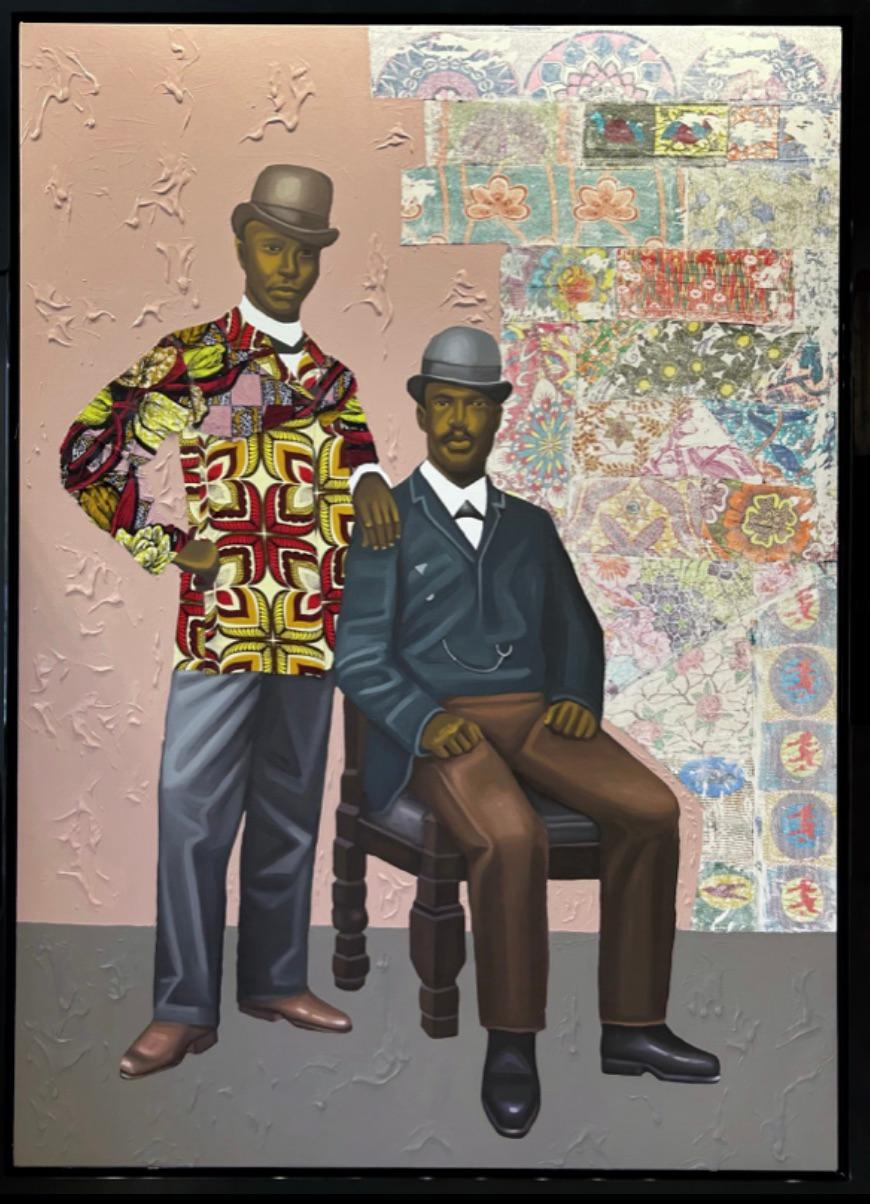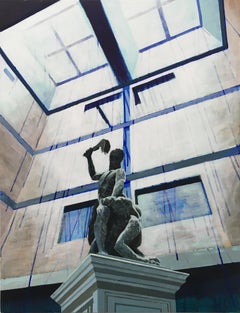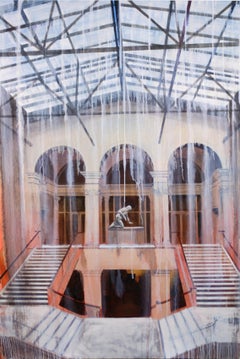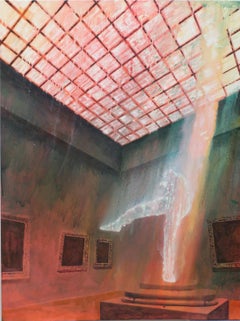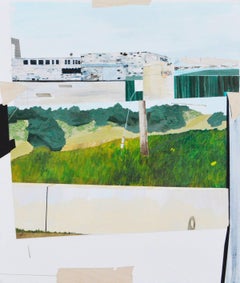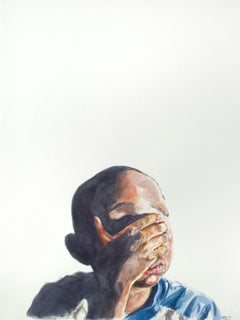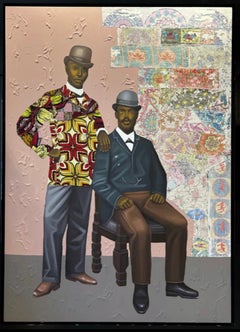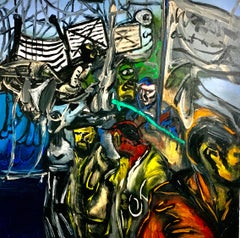Want more images or videos?
Request additional images or videos from the seller
1 of 5
Chris BarnardC'mon, son!2017
2017
$2,500
£1,890.60
€2,165.57
CA$3,503.10
A$3,824.21
CHF 2,013.49
MX$45,809.56
NOK 25,751.83
SEK 23,511.85
DKK 16,177.33
About the Item
This depicts an Art Institute of Chicago gallery space with a fictional sculpture. The two men rendered in the sculpture are based on white youth who attacked and beat Ted Landsmark, a black lawyer, outside Boston City Hall in 1976. The white youth were protesting a forced integration bussing system in the public schools.
[b. 1977 – New York, NY ::: lives & works – New Haven, CT]
CHRIS BARNARD received his BA from Yale and his MFA from The University of Southern California (USC) in Los Angeles. Having previously held faculty positions at Denison University, Indiana University, and USC, Barnard is currently associate professor of art at Connecticut College in New London.
Barnard’s work has been shown in solo and group exhibitions in Los Angeles, New York, Chicago, and New Haven, among other locations, and can be found in public and private collections nationally and internationally. His work is represented by Fred Giampietro Gallery in New Haven, where he and his partner live.
artist statement
In my work I focus on white supremacy’s relationship to the privileged spaces of my experiences, such as private art and educational institutions. Amidst widening gaps in wealth and opportunity, discussions about race, power, justice and representation—across visual culture broadly—seem more relevant than ever.
In many of my compositions, which reference real sites, I have inserted fictional elements to raise questions about the allegiances and priorities of these institutions, as well as people—including myself—who have benefitted from, or continue to support them. The resulting works are representational, but through gestural passages and color and surface manipulation, I aim to suggest instability, corrosion and decay. In the end, I strive to make engaging paintings that suggest dissonance and ambivalence, that entice and challenge viewers, just as painting them does for me.
These paintings are rooted in my contemplating Whiteness and emerge from wrestling with the politics of painting—the connections and gaps between painting and lived experience. They also reflect: a love of paint, the act of painting, and the power of the painted image; a regard for practitioners past and present, as well as those for whom practice has not been possible; and an admission of painting’s complicity with hegemonic power. As always, my process remains driven by questions. In this case, questions like: What role does painting play in the face of concrete social crises? How can my paintings respectfully incorporate¬—rather than exploit—relevant and thought-provoking content and imagery? What does it mean to think about racism, dehumanization, injustice, etc., and then to paint such pictures, and in particular as a straight, White man?
These questions and this body of work owe much to the work of others, and most acutely to four scholars’ books in particular: The History of White People, by Nell Irvin Painter; Ebony and Ivy: Race, Slavery, and the Troubled History of America’s Universities by Craig Steven Wilder; The New Jim Crow: Mass Incarceration in the Age of Colorblindness, by Michelle Alexander; and White Rage, by Carol Anderson. I am greatly indebted to the depth of research and insight that these books represent; each was inspiring as much as it was devastating. These people’s work, among others, influenced my own immeasurably, concretely sparking ideas for compositions, and more ephemerally—but equally importantly—by setting a standard, a tone, and a spirit for me in the studio that I strive to honor.
There is always danger in making art in response to inhumanity and suffering. I do so sincerely and humbly, without claiming success or certainty. And certainly, I recognize that painting has its limitations when compared to direct social action. That said, I believe art enables interaction and introspection for individuals, as well as creates opportunities for dialogue and discussion. My hope is that these works communicate a degree of internal struggle—among and between compositions, materials, processes, intents, and experiences—but, even more importantly, provoke conversation and critical thought.
- Creator:Chris Barnard (American)
- Creation Year:2017
- Dimensions:Height: 24 in (60.96 cm)Width: 20 in (50.8 cm)
- Medium:
- Movement & Style:
- Period:
- Condition:
- Gallery Location:New Orleans, LA
- Reference Number:1stDibs: LU10524925531
About the Seller
5.0
Platinum Seller
Premium sellers with a 4.7+ rating and 24-hour response times
Established in 1998
1stDibs seller since 2015
181 sales on 1stDibs
Typical response time: <1 hour
- ShippingRetrieving quote...Shipping from: New Orleans, LA
- Return Policy
More From This Seller
View AllBlue Blood
By Chris Barnard
Located in New Orleans, LA
A view of the sculpture in the entryway of the Yale Center for British Art. 'Blue Blood' is a nickname for Yale graduates, but as Nell Irvin Painter writes ...
Category
21st Century and Contemporary Contemporary Figurative Paintings
Materials
Acrylic, Panel
The Evidence of Things Seen
By Chris Barnard
Located in New Orleans, LA
An abstracted view of the Art Institute of Chicago's Grand Staircase. The lone sculpture fictionally represents an armed officer pointing a gun at an absent figure.
[b. 1977 – New York, NY ::: lives & works – New Haven, CT]
CHRIS BARNARD received his BA from Yale and his MFA from The University of Southern California (USC) in Los Angeles. Having previously held faculty positions at Denison University, Indiana University, and USC, Barnard is currently associate professor of art at Connecticut College in New London.
Barnard’s work has been shown in solo and group exhibitions in Los Angeles, New York, Chicago, and New Haven, among other locations, and can be found in public and private collections nationally and internationally. His work is represented by Fred Giampietro Gallery in New Haven, where he and his partner live.
artist statement
In my work I focus on white supremacy’s relationship to the privileged spaces of my experiences, such as private art and educational institutions. Amidst widening gaps in wealth and opportunity, discussions about race, power, justice and representation—across visual culture broadly—seem more relevant than ever.
In many of my compositions, which reference real sites, I have inserted fictional elements to raise questions about the allegiances and priorities of these institutions, as well as people—including myself—who have benefitted from, or continue to support them. The resulting works are representational, but through gestural passages and color and surface manipulation, I aim to suggest instability, corrosion and decay. In the end, I strive to make engaging paintings that suggest dissonance and ambivalence, that entice and challenge viewers, just as painting them does for me.
These paintings are rooted in my contemplating Whiteness and emerge from wrestling with the politics of painting—the connections and gaps between painting and lived experience. They also reflect: a love of paint, the act of painting, and the power of the painted image; a regard for practitioners past and present, as well as those for whom practice has not been possible; and an admission of painting’s complicity with hegemonic power. As always, my process remains driven by questions. In this case, questions like: What role does painting play in the face of concrete social crises? How can my paintings respectfully incorporate¬—rather than exploit—relevant and thought-provoking content and imagery? What does it mean to think about racism, dehumanization, injustice, etc., and then to paint such pictures, and in particular as a straight, White man?
These questions and this body of work owe much to the work of others, and most acutely to four scholars’ books in particular: The History of White People, by Nell Irvin Painter; Ebony and Ivy: Race, Slavery, and the Troubled History of America’s Universities by Craig Steven Wilder; The New Jim Crow: Mass Incarceration in the Age of Colorblindness, by Michelle Alexander; and White Rage, by Carol Anderson...
Category
21st Century and Contemporary Contemporary Figurative Paintings
Materials
Canvas, Oil, Panel
Kicking and Screaming
By Chris Barnard
Located in New Orleans, LA
Based on one of the painting galleries at the Met, but with a fictionalized sculpture, the form of which is based on an iconic photo by Will Counts, capturing a white segregationist kicking Alex Wilson, a black journalist, in the head on Sep. 23, 1957. Alex Wilson was in Little Rock, AR, as the 'Little Rock Nine' attempted to enter the segregated public schools.
[b. 1977 – New York, NY ::: lives & works – New Haven, CT]
CHRIS BARNARD received his BA from Yale and his MFA from The University of Southern California (USC) in Los Angeles. Having previously held faculty positions at Denison University, Indiana University, and USC, Barnard is currently associate professor of art at Connecticut College in New London.
Barnard’s work has been shown in solo and group exhibitions in Los Angeles, New York, Chicago, and New Haven, among other locations, and can be found in public and private collections nationally and internationally. His work is represented by Fred Giampietro Gallery in New Haven, where he and his partner live.
artist statement
In my work I focus on white supremacy’s relationship to the privileged spaces of my experiences, such as private art and educational institutions. Amidst widening gaps in wealth and opportunity, discussions about race, power, justice and representation—across visual culture broadly—seem more relevant than ever.
In many of my compositions, which reference real sites, I have inserted fictional elements to raise questions about the allegiances and priorities of these institutions, as well as people—including myself—who have benefitted from, or continue to support them. The resulting works are representational, but through gestural passages and color and surface manipulation, I aim to suggest instability, corrosion and decay. In the end, I strive to make engaging paintings that suggest dissonance and ambivalence, that entice and challenge viewers, just as painting them does for me.
These paintings are rooted in my contemplating Whiteness and emerge from wrestling with the politics of painting—the connections and gaps between painting and lived experience. They also reflect: a love of paint, the act of painting, and the power of the painted image; a regard for practitioners past and present, as well as those for whom practice has not been possible; and an admission of painting’s complicity with hegemonic power. As always, my process remains driven by questions. In this case, questions like: What role does painting play in the face of concrete social crises? How can my paintings respectfully incorporate¬—rather than exploit—relevant and thought-provoking content and imagery? What does it mean to think about racism, dehumanization, injustice, etc., and then to paint such pictures, and in particular as a straight, White man?
These questions and this body of work owe much to the work of others, and most acutely to four scholars’ books in particular: The History of White People, by Nell Irvin Painter; Ebony and Ivy: Race, Slavery, and the Troubled History of America’s Universities by Craig Steven Wilder; The New Jim Crow: Mass Incarceration in the Age of Colorblindness, by Michelle Alexander; and White Rage, by Carol Anderson...
Category
21st Century and Contemporary Contemporary Figurative Paintings
Materials
Canvas, Oil, Panel
P4011
By Jenny Day
Located in New Orleans, LA
Jenny Day is a painter who divides her time between Santa Fe, New Mexico and Tucson, Arizona. She paints a fragmented space, examining human demand and the effects of environmental d...
Category
21st Century and Contemporary Contemporary Landscape Paintings
Materials
Mixed Media, Acrylic, Color Pencil
$1,875
Long Time Ago
By Starsky Brines
Located in New Orleans, LA
STARSKY BRINE’s paintings and drawings captivate audiences with their distinctive style and a recurring theme, the search for the nature of humanity. In his bold works, the artist fo...
Category
21st Century and Contemporary Contemporary Abstract Paintings
Materials
Canvas, Crayon, Acrylic, Spray Paint
How?
By Ruth Owens
Located in New Orleans, LA
[ New Orleans, LA :: b.1959, Augsburg, Germany ]
In 1959, Ruth Owens was born to a young German woman and a Black serviceman from Georgia. The nomadic military lifestyle of her chi...
Category
21st Century and Contemporary Contemporary Figurative Paintings
Materials
Oil
$7,500
You May Also Like
untitled
By Darius Steward
Located in Fairlawn, OH
Signed with the artist's initials lower right
Watercolor on Twinrocker heavy weight paper
Category
2010s Contemporary Figurative Paintings
Materials
Watercolor
New Stories
Located in Zofingen, AG
From the City Stories series, New Stories portrays the quiet poetry of urban encounters. Figures gather around a café beneath a bright awning, some pausing in conversation, others si...
Category
2010s Contemporary Figurative Paintings
Materials
Canvas, Acrylic
Untitled
Located in PARIS, FR
Mixed Technique
Collage, Textile, Acrylic on Canvas
Category
2010s Contemporary Figurative Paintings
Materials
Textile, Acrylic
Chinese Contemporary Art by Renjie Gao - Untitled
By Renjie Gao
Located in Paris, IDF
Oil on canvas
Renjie Gao or Jean-Michel Gao is a Chinese artist born in 1994 in Inner Mongolia. He is a member of New York Hudson Artists Association based in US. He lives & works i...
Category
2010s Contemporary Portrait Paintings
Materials
Canvas, Oil
I Still Haven't Found What I'm Looking For
Located in Brooklyn, NY
John-Herbert was born in Miami and moved to New York city when he was 3 years old. As the son of a Filipno mother and bi-racial father, his multi-cultural roots at first felt like a challenge but with time, and especially through his creative explorations, he would create his own unique world. This would immerse into his work; containing multiple points of views. Inspirations from Basquiat to Van Gogh, Monet to Dali and Matisse; John-Herbert developed a Neo-Expressionist approach infused with surrealism, figurative, and abstract renderings.
From the tender age of eight, Wright gravitated to painting as an escape expressing a rich inner world. His work heavily relies upon dark figurations amongst an urban landscape leaving the viewer space to navigate the world he creates. An analogy of the human condition; centering the female nude/mother and child as the protagonist, he tells the story of the broken seeking respite, the downcast, the other.
Wright seeks to illuminate the universe of darkness within all of us, within himself, and that darkness contrasted with fragility has always been at the epicenter of his work.
Wright has managed to create a niche for himself as a painter and street-wear designer, contributing to the role the graphic t-shirt played in disseminating New York street culture across the globe. Transferring the techniques of garment making onto his canvases, Wright’s paintings feature backdrops of multiple layers of silk-screened images, drawings and text. He has also expanded his avenues of expression, creating installations and even multi-sensory exhibitions, building even more detailed spaces to travel with him through.
Although his success has been celebrated, in many ways till recently, Wright has also kept his own story on fade. This changed last year with his highly lauded solo show “Rewind & Reflect” (at the Blue Gallery...
Category
2010s Contemporary Figurative Paintings
Materials
Canvas, Mixed Media
$9,600 Sale Price
20% Off
It Wasn't That Long Ago
By Darren LeGallo
Located in West Hollywood, CA
We are proud to premiere the latest works by American artist Darren LeGallo.
Our second exhibition, Darren LeGallo, "From Destruction" has j...
Category
2010s Contemporary Figurative Paintings
Materials
Mixed Media
Price Upon Request
